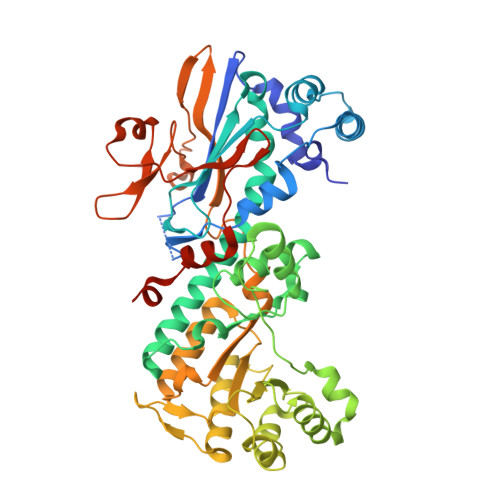Structural Basis for Resistance to Diverse Classes of NAMPT Inhibitors.
Wang, W., Elkins, K., Oh, A., Ho, Y.C., Wu, J., Li, H., Xiao, Y., Kwong, M., Coons, M., Brillantes, B., Cheng, E., Crocker, L., Dragovich, P.S., Sampath, D., Zheng, X., Bair, K.W., O'Brien, T., Belmont, L.D.(2014) PLoS One 9: e109366-e109366
- PubMed: 25285661
- DOI: https://doi.org/10.1371/journal.pone.0109366
- Primary Citation of Related Structures:
4O13, 4O14, 4O15, 4O16, 4O17, 4O18, 4O19, 4O1A, 4O1B, 4O1C, 4O1D, 4O28 - PubMed Abstract:
Inhibiting NAD biosynthesis by blocking the function of nicotinamide phosphoribosyl transferase (NAMPT) is an attractive therapeutic strategy for targeting tumor metabolism. However, the development of drug resistance commonly limits the efficacy of cancer therapeutics. This study identifies mutations in NAMPT that confer resistance to a novel NAMPT inhibitor, GNE-618, in cell culture and in vivo, thus demonstrating that the cytotoxicity of GNE-618 is on target. We determine the crystal structures of six NAMPT mutants in the apo form and in complex with various inhibitors and use cellular, biochemical and structural data to elucidate two resistance mechanisms. One is the surprising finding of allosteric modulation by mutation of residue Ser165, resulting in unwinding of an α-helix that binds the NAMPT substrate 5-phosphoribosyl-1-pyrophosphate (PRPP). The other mechanism is orthosteric blocking of inhibitor binding by mutations of Gly217. Furthermore, by evaluating a panel of diverse small molecule inhibitors, we unravel inhibitor structure activity relationships on the mutant enzymes. These results provide valuable insights into the design of next generation NAMPT inhibitors that offer improved therapeutic potential by evading certain mechanisms of resistance.
- Genentech, Inc., South San Francisco, California, United States of America.
Organizational Affiliation:



















